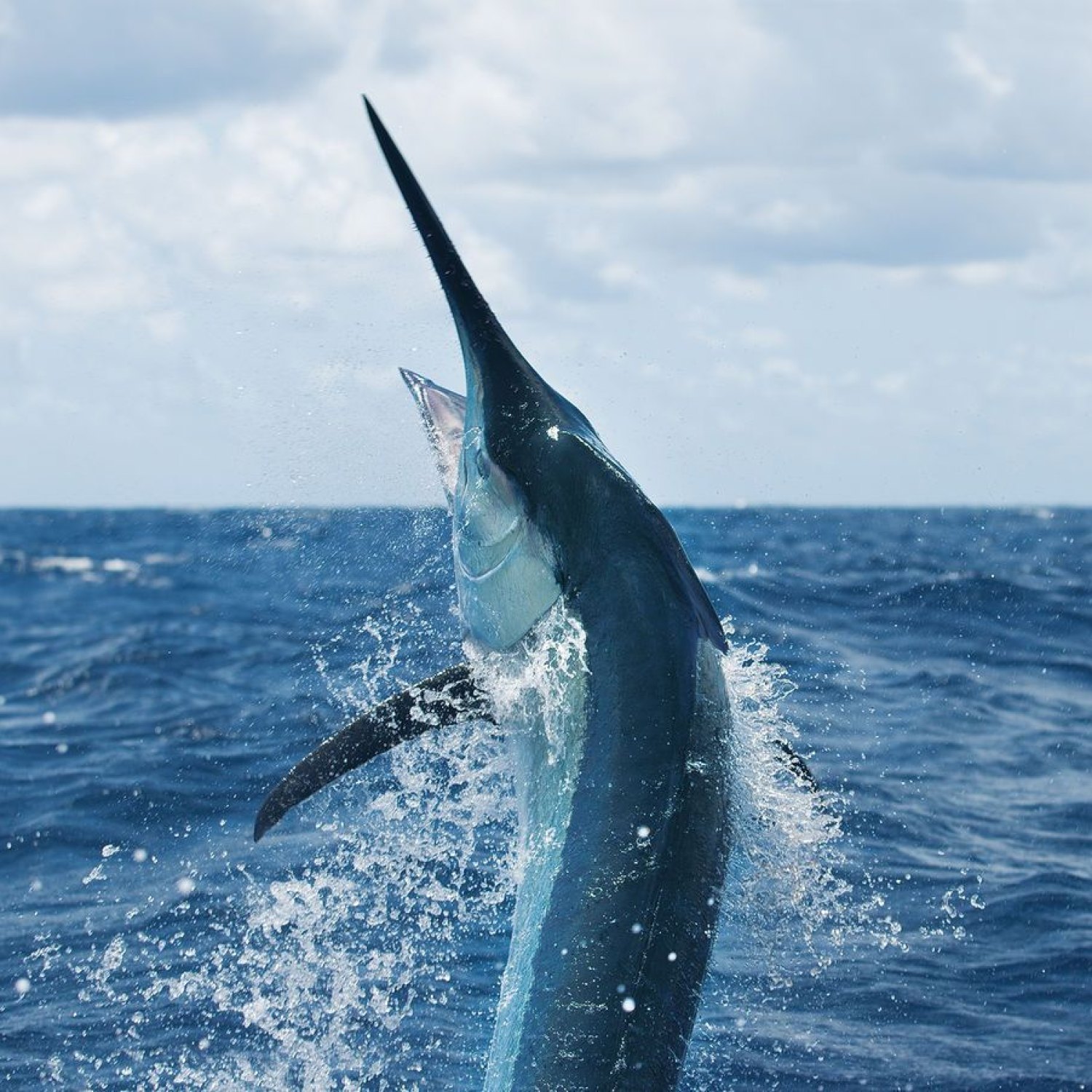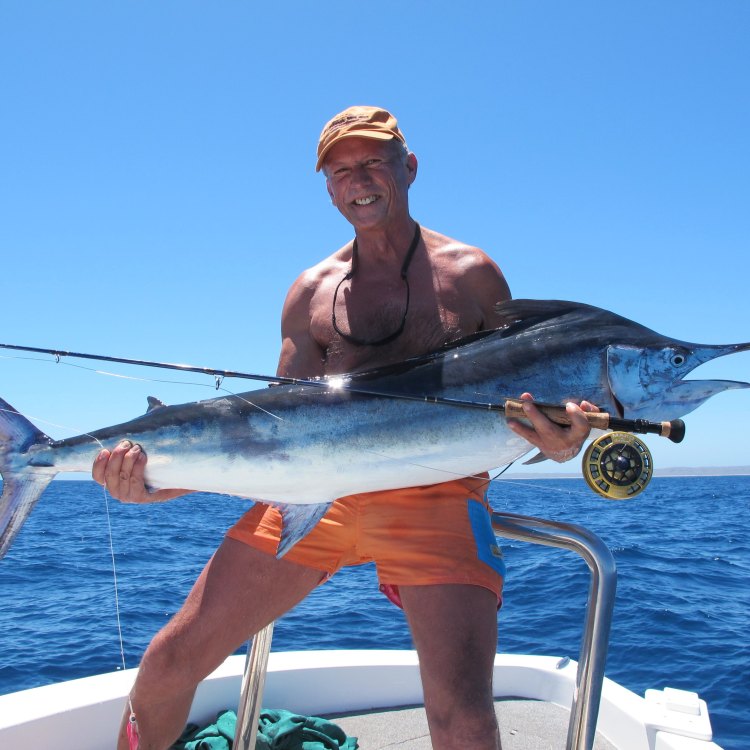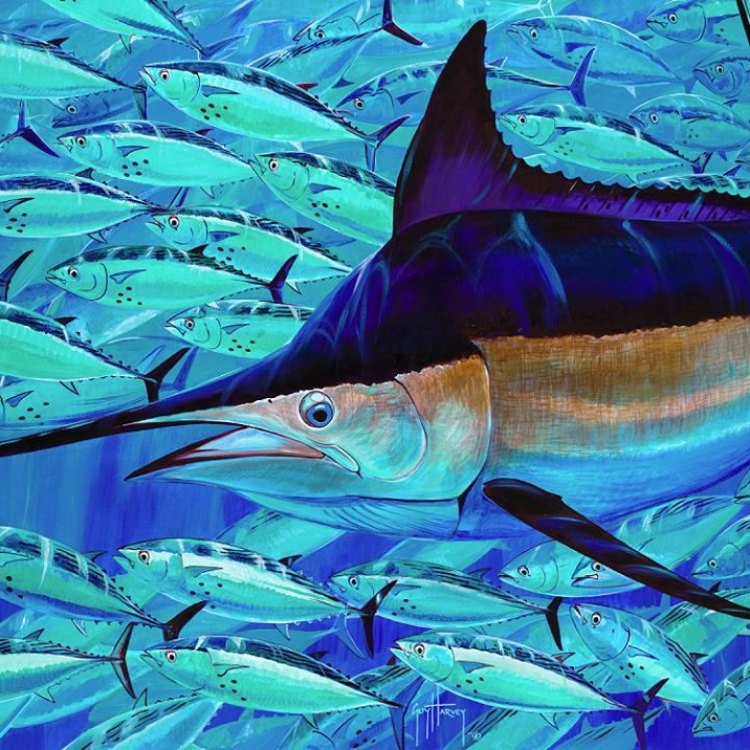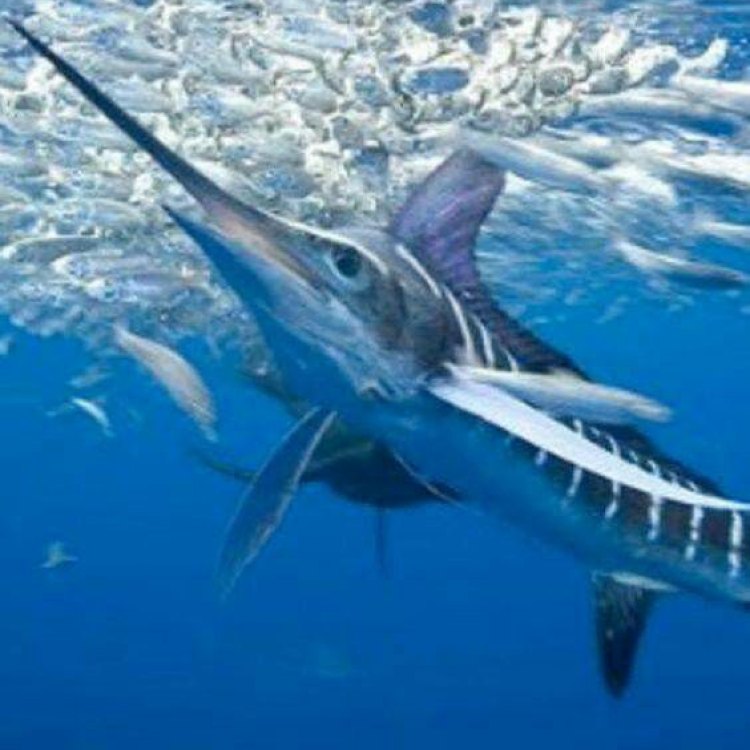
Black Marlin
Up to 5 meters
Named after its dark blue-black color, the Black Marlin is one of the largest fish in the world, reaching lengths of up to 5 meters. This majestic creature is commonly found in coral reefs and open ocean waters, belonging to the Istiophoridae family. Its streamlined and elongated body makes it a powerful and agile swimmer, making it a favorite among sport fishermen. Encounter this impressive animal on your next diving or fishing expedition!
Animal Details Summary:
Common Name: Black Marlin
Kingdom: Animalia
Habitat: Marine
The Darkness of the Sea: The Black Marlin
Have you ever wondered what lurks in the depths of the ocean? The dark and mysterious creatures that roam, hidden from our sight. One such creature is the Black Marlin, a formidable and majestic predator that rules the tropical and sub-tropical waters of the Indian and Pacific Oceans. Its scientific name is Istiompax indica, but it is more commonly known as the Black Marlin.The Black Marlin belongs to the animal kingdom, specifically the phylum Chordata Black Marlin. Its class is Actinopterygii, which means it has ray-finned fish. This type of fish is known for its bony and spiny rays in its fins, giving it a unique appearance. It belongs to the order Perciformes, which includes over 10,000 different species of fish. The Black Marlin is part of the family Istiophoridae, along with other billfish such as the sailfish and swordfish.
The Black Marlin is a true king of the ocean, and its habitat reflects that. It is found in the warm waters of the marine environment. Unlike other fish, it prefers to stay in the open ocean rather than near shores or reefs. However, it can also be found near coral reefs and feeding on smaller fish and squid. Despite its preference for open water, the Black Marlin is known to travel long distances in search of food, sometimes even crossing entire oceans Boxsky.
As a carnivorous fish, the Black Marlin is a skilled predator. With its sleek, streamlined body and powerful muscles, it can reach incredible speeds in the water, making it an impressive hunter. It uses its sharp bill to stun and slash its prey, making it an efficient killer. Its diet consists of various types of fish, including tuna, mackerel, and even smaller marlin. It is also known to feed on squid and other cephalopods.
The Black Marlin has a wide geographical distribution, found in tropical and sub-tropical waters of the Indian and Pacific Oceans. However, its country of origin is said to be Australia, where it is considered a prized game fish. Many fishermen flock to Australia every year in search of these powerful creatures, making it a popular sport fishing destination.
When it comes to appearance, the Black Marlin is truly a sight to behold. Its name is derived from its coloration, as the top of its body is a dark blue or black with shimmering scales, while the bottom is silver or white. This coloration provides camouflage, making it difficult for predators to spot the Black Marlin from above or below. Additionally, its elongated and streamlined body allows it to move gracefully through water, almost like a dark blur.
The Black Marlin is a large fish, with some individuals reaching lengths of up to 5 meters and weighing over a thousand pounds. It has a long, pointed snout, and its upper jaw extends into a long spear-like bill. This bill is what sets it apart from other billfish and makes it a true apex predator. Along with its powerful swimming abilities, it is also equipped with strong, sharp teeth, making it a fearsome opponent for any prey.
One of the most fascinating aspects of the Black Marlin is its ability to change color. When hunting, its dark blue or black coloration becomes even darker, almost appearing black, allowing it to blend in with the deep sea. However, when it is excited or agitated, its color turns a bright, metallic blue. This change in coloration is thought to be a form of communication between individuals, signaling aggression or mating behaviors.
Despite being a skilled and powerful hunter, the Black Marlin is also a highly sought-after prey for humans. Its meat is considered a delicacy in many countries, and its trophy size makes it a coveted catch for sport fishermen. However, due to overfishing and commercial fishing practices, the Black Marlin population has decreased in recent years. It is currently listed as a vulnerable species, and efforts are being made to protect and conserve its population.
In conclusion, the Black Marlin is an impressive and mysterious creature that calls the vast, open seas its home. Its majestic appearance, powerful hunting abilities, and wide distribution make it a truly remarkable species. While it may be a force to be reckoned with in the depths of the ocean, it also needs our protection and conservation efforts to continue thriving in its natural habitat. Who knows what other secrets and mysteries await us in the darkness of the sea?

Black Marlin
Animal Details Black Marlin - Scientific Name: Istiompax indica
- Category: Animals B
- Scientific Name: Istiompax indica
- Common Name: Black Marlin
- Kingdom: Animalia
- Phylum: Chordata
- Class: Actinopterygii
- Order: Perciformes
- Family: Istiophoridae
- Habitat: Marine
- Feeding Method: Carnivorous
- Geographical Distribution: Tropical and Subtropical waters of the Indian and Pacific Oceans
- Country of Origin: Australia
- Location: Coral reefs, open ocean
- Animal Coloration: Dark blue or black on the top and silver or white on the belly
- Body Shape: Streamlined and elongated body
- Length: Up to 5 meters

Black Marlin
- Adult Size: Up to 5 meters
- Average Lifespan: 20 years
- Reproduction: Sexual
- Reproductive Behavior: Spawning in warm waters
- Sound or Call: Not known for vocalizations
- Migration Pattern: Highly migratory
- Social Groups: Solitary or small groups
- Behavior: Fast and powerful swimmers
- Threats: Overfishing, habitat degradation, bycatch
- Conservation Status: Least Concern
- Impact on Ecosystem: Apex predator
- Human Use: Game fishing
- Distinctive Features: Long, pointed bill and a tall, crescent-shaped dorsal fin
- Interesting Facts: Black Marlins are one of the fastest fish in the ocean, capable of reaching speeds of up to 82 km/h (50 mph)
- Predator: Sharks, humans

Istiompax indica
The Mighty Black Marlin: A Powerful Apex Predator of the Ocean
The ocean is a vast, mysterious world filled with countless creatures, each with its own unique characteristics and role in the ecosystem. Among these creatures is the mighty black marlin, a fast and powerful fish that roams the warm waters of the world's oceans.Known for its impressive size and speed, the black marlin is a highly migratory species found in tropical and subtropical waters around the globe. It is a prized game fish for anglers and holds a special place in the hearts of recreational fishermen and conservationists alike PeaceOfAnimals.Com. In this article, we will dive into the world of the black marlin and discover what makes this apex predator so fascinating.
Adult Size and Average Lifespan
The black marlin, also known as Istiompax indica, is one of the largest bony fishes in the world. They can reach lengths of up to 5 meters (16 feet) and weigh over 700 kilograms (1,500 pounds). These magnificent creatures are second only to the blue marlin in terms of size.
Despite its impressive size, the average lifespan of the black marlin is only around 20 years. This is a relatively short lifespan compared to other marine animals, such as whales and sea turtles, which can live for several decades. However, the black marlin's rapid growth rate compensates for its short lifespan, with some individuals growing up to 40 cm (16 inches) in a single year.
Reproduction and Reproductive Behavior
Like many fish species, black marlins reproduce sexually. They reach sexual maturity at around 2 years of age, when they are approximately 160 cm (5 feet) in length Black Throat Monitor. Female black marlins are generally larger and lay millions of eggs every year, which are fertilized externally by male black marlins during spawning season.
Interestingly, black marlins exhibit what is known as broadcast spawning, where the female releases her eggs into the water column and the males release their sperm, hoping to fertilize as many eggs as possible. Spawning takes place in warm waters, usually during the summer months when the ocean temperatures are at their highest.
Sound or Call and Migration Pattern
Unlike some marine animals that are known for their vocalizations, black marlins are not known for any specific sounds or calls. However, they are highly migratory, traveling long distances across the ocean in search of food and suitable spawning grounds.
Black marlins are found in both the Pacific and Indian Oceans, and their migration patterns can be influenced by ocean currents, temperature changes, and food availability. They are known to travel thousands of miles in a single year, making them one of the most migratory fish species in the world.
Social Groups and Behavior
Black marlins are solitary creatures, but they can sometimes be found in small groups of 2-3 individuals. They are generally not social animals and prefer to roam the open ocean alone, except during breeding season when they gather in larger groups for spawning.
These fish are incredibly fast and powerful swimmers, using their long, pointed bill and tall, crescent-shaped dorsal fin to cut through the water with ease. They are known to reach speeds of up to 82 km/h (50 mph), making them one of the fastest fish in the ocean. Their impressive speed and agility allow them to catch prey and evade predators efficiently.
Threats and Conservation Status
As apex predators, black marlins play a vital role in maintaining balance and biodiversity in the oceans. However, like many marine animals, they are facing numerous threats that could potentially harm their population and the health of the marine ecosystem.
The biggest threat to black marlins is overfishing. They are a popular game fish, with recreational and commercial fishermen targeting them for sport and food. This has put a significant strain on their population, and their slow reproductive rate makes it challenging for them to recover from overexploitation.
Habitat degradation, specifically through the destruction of coral reefs, also poses a threat to black marlins. These fish rely on coral reefs for shelter and as a source of food, and any damage to these vital habitats could have serious consequences for their survival.
Additionally, black marlins are also susceptible to becoming bycatch, unintentionally caught in fishing nets and gear set for other species. This can lead to injury or death for these fish, further impacting their population.
Despite these threats, the black marlin is currently listed as a species of Least Concern on the IUCN Red List. However, continuous monitoring and conservation efforts are necessary to ensure the long-term survival of these majestic creatures.
Impact on the Ecosystem and Human Use
As apex predators, black marlins have a significant impact on the marine ecosystem. Their role as top predators helps regulate the populations of their prey species, preventing overpopulation and maintaining a healthy balance in the ocean's food web.
Moreover, their presence can also indicate the health of their habitat. If black marlins are thriving in a particular area, it is a good sign that the ecosystem is in good condition. However, their decline could be a warning sign of environmental issues that need to be addressed.
Human use of black marlins is primarily focused on game fishing. These fish are highly sought after by recreational fishermen for their speed and strength, making them an exciting and challenging catch. However, it is essential to practice responsible and sustainable fishing methods to ensure the long-term survival of this species.
Interesting Facts and Predators
Lastly, let's take a look at some exciting facts and the predators of the black marlin. As mentioned earlier, these fish are one of the fastest swimmers in the ocean, capable of reaching speeds of up to 82 km/h (50 mph). This impressive speed allows them to catch prey and escape from predators with ease.
Speaking of predators, black marlins are not invincible. They are also preyed upon by sharks, who see them as a valuable food source. However, humans are the biggest predator of black marlins, primarily through overfishing and bycatch. It is estimated that the global annual catch of black marlins is around 55,000 fish, a concerning number for a species with a slow reproductive rate.
In Conclusion
The black marlin is undoubtedly a formidable creature of the ocean, with its impressive size, speed, and role as an apex predator. Despite facing various threats, these fish continue to capture the interest and admiration of fishermen and marine enthusiasts around the world. It is essential to protect and conserve this magnificent species, not only for its intrinsic value but also for the health of the ocean's delicate ecosystem. Let us work together to ensure that the mighty black marlin continues to swim in our oceans for many years to come.

The Darkness of the Sea: The Black Marlin
Disclaimer: The content provided is for informational purposes only. We cannot guarantee the accuracy of the information on this page 100%. All information provided here may change without prior notice.












